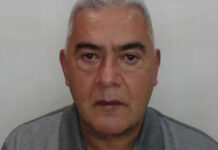By Carlos Tablante
The announcement by the Attorney General of Venezuela, Luisa Ortega Díaz, of the inclusion of Rafael Isea in the Red Code list of the International Police (Interpol) took Venezuelans by surprise and made some people believe that thighs where going to change. Some thought that the government had finally accumulated enough evidence against the former Minister of Finance and former governor of the Aragua state regarding his questioned performance in the public administration; but soon Ortega Díaz showed what all this really was about: the scandalous acts of corruption involving the structured notes will remain buried in silence.
Although the major eruption of corruption with structured notes occurred during the administration of Rafael Isea, a retired military, there were other people involved in this perverse game; people that have never been investigated. Without a doubt, the case of the structured notes is one of the longest and darkest episodes carried out by the revolutionary bourgeoisie, known as ‘boli-burguesía’ (Bolivarian-bourgeoisie).
The strategy of issuing bonds denominated in dollars but payable in bolivars (a mechanism designed to distribute foreign currency to shell companies and individuals illegally trading dollars in the black market) started in 2003 when Tobías Nobrega was appointed Minister of Finance and the exchange control, the longest in the history of Venezuela, was implemented. The mechanism was simple: selected shell companies, brokers and government officials received dollars at the official rate (the cheapest one) and sold them at a higher rate in the black market, obtaining remarkable profits.
The idea of these bonds is attributed to Francisco Illarramendi, by the time an advisor to Minister Nóbrega. Illaramendi is the same guy that defrauded the Pension Fund of PDVSA’s workers (PDVSA is the Venezuelan oil state company). This is the same guy that the Venezuelan Attorney General’s Office omitted to investigate and that was acquitted by a Venezuelan court. This is the same guy that was then investigated by the US authorities and is now expecting conviction. This story illustrates the «willful blindness» of those that, from the corridors of power, see acts of corruption and look the other way, especially when it is in their own convenience. A ”grand slam”: this is how Illaramendi described the idea of the bonds to his accomplice Moris Beracha in a conversation that was made public during Illaramendi’s trial in a Connecticut court.
The “great business” of the Venezuelan bonds started with Tobías Nóbrega at the head of the Ministry of Finance, but subsequent ministers decided to continue using the same mechanism to keep trading debt securities with banks carefully selected according to their convenience (again, the boli-burgeoisie) and without any transparency.
But the big strike was yet to come: it happened with the structured notes, a set of financial instruments backed up with the public debts of Argentina, Ecuador and Venezuela.
According to estimations made by some economists familiar with this case, more than US$ 10 billion were placed in structured notes and traded without any supervision between 2004 and 2008.
Tobías Nobrega was eventually replaced by Nelson Merentes, who is attributed to have come up with the idea of using resources from the National Development Fund (Fondo para el Desarrollo Nacional, Fonden) for the acquisition of structured notes. These instruments, which included junk bonds, were sold to banks and brokerage firms selected without carrying out any auction or even knowing the price and the exchange rates of the operations. The list of the financial institutions involved was not disclosed either. However, the Venezuelan government ended up intervening most of these institutions soon after.
Carmen Meléndez, former Minister of Defense and current Minister of Interior, Justice and Peace, participated in the negotiation of more than US$ 9,000 million (at official rate) in bonds and structured notes while serving as National Treasurer in 2006 with the complicity of Nelson Merentes.
The structured notes were very attractive to banks, brokerage firms and other financial operators because they could be acquired in bolivars and sold in dollars in the international markets, leaving remarkable profits due to the exchange rate differential.
In 2007, Rodrigo Cabezas was appointed Minister of Finance and Lieutenant Alejandro Andrade, a military from the trusted circle of President Hugo Chávez (like Rafael Isea), was appointed National Treasurer. Andrade got involved in the fraud with the structured notes. This allowed him to strengthen his ties with bankers from the boli-bourgeoisie.
Although Rodrigo Cabezas said that during his tenure as Minister of Finance no purchase of structured notes were made, he admitted that in 2007, with the full support of President Hugo Chávez, the structured notes that had been acquired in 2006 were placed in the market because of their risky nature. This means that if the General Attorney’s and the General Comptroller’s offices decided to investigate the case of the structured notes, Rodrigo Cabezas should be called as a witness to contribute to an investigation that has not happened yet. He surely has a lot to say.
The Ministry of Finance thus became a huge stage of the so called casino-capitalism, where a few gamblers used public assets belonging to all Venezuelans for their own benefit.
Four months at the head of the Ministry of Finance sufficed for Rafael Isea to star in one of the greatest cases of corruption and influence peddling in the history of Venezuela.
In May 21st, 2008, right after Rafael Isea was removed from the Ministry of Finance, the Venezuelan website Analítica.com published an article entitled ”Isea is gone, who will replace him?”. There it was written: «One day, Rafael Isea will have to go to court to respond for the management of the Bandes’ funds. The audited balance sheets for 2006 and the first half of 2007 show that the Bandes lent money to Venezuelan union entities like Empresarios por Venezuela (Entrepreneurs for Venezuela, Empreven, an association basically created to seek government contracts and loans), as well as the funding of foreign companies like dairy cooperative Sancor of Argentina. It also lent money to Cuba without warranties and condoned Nicaragua’s debt. Isea must also be called to justice for a management characterized by heavy losses, which includes the closing of the branch in Uruguay. The Bandes and the Industrial Bank of Venezuela were the only two financial institutions reporting losses during that period».
The structured notes not only benefited Rafael Isea: Alejandro Andrade, then National Treasurer, and Moris Beracha, a consultant, also received hefty commissions and colluded with pseudo-bankers and stockbrokers to further benefit from the placement of public funds, a situation that became apparent during the 2009-2011 financial crises.
It is clear that including Rafael Isea in Interpol’s Red Code does not seek to punish the people responsible for the structured notes fraud or recover the funds that were stolen from the public arks.
Instead, it is just a warning message aiming to show who won the internal fight in the ruling party. In the meantime, while witnessing this profusion of corruption and impunity, we continue to demand justice.











